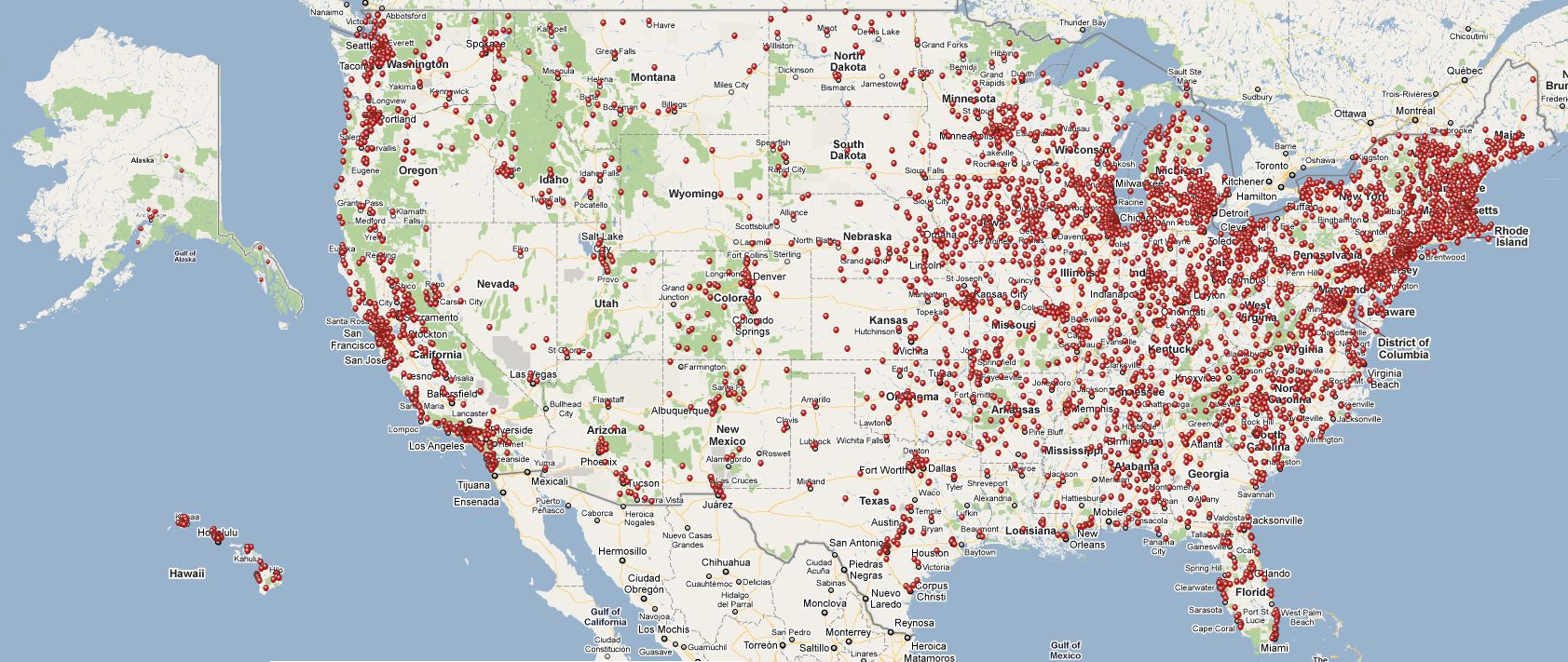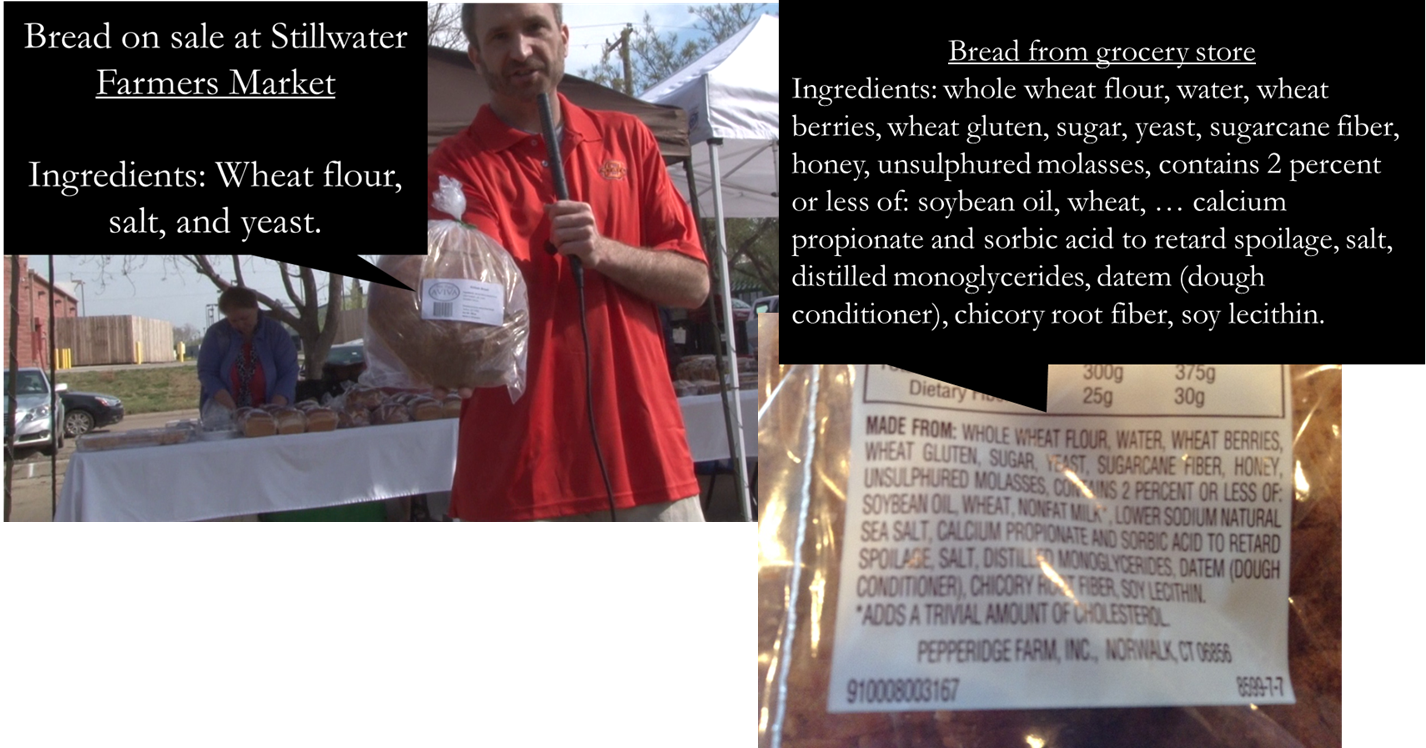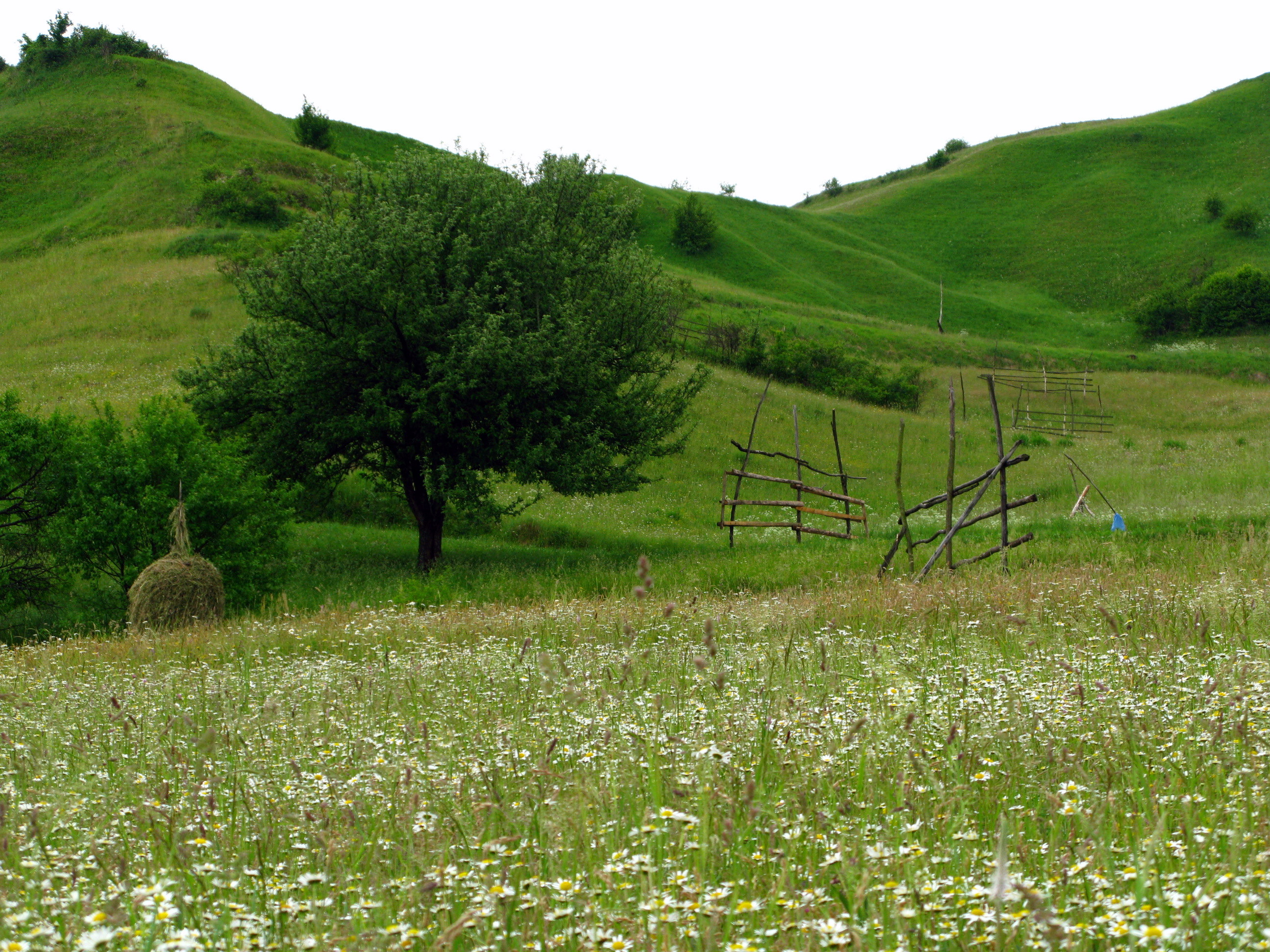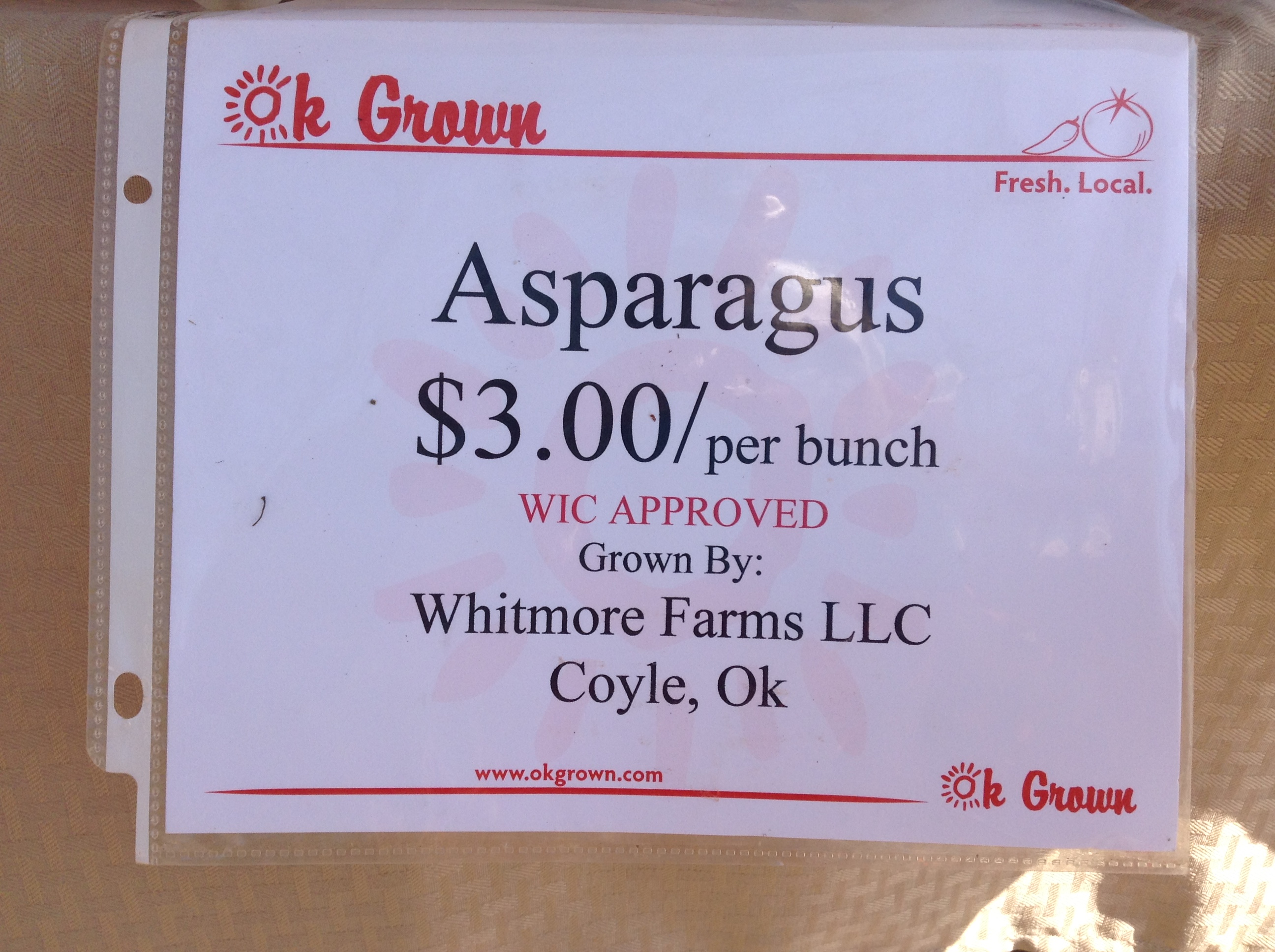

The appeal of farmers markets
Although farmers markets seem fashionable today, local foods have always been sold directly to local consumers, whether it be street vendors, food retailers able to sell local produce, black markets for food in Communist China, or the formal farmers markets available to most Americans today. Wherever there are high population densities, there are farmers markets, but even many small towns in the midwest have decent access to farmers markets.
Figure 1—A nation of farmers markets (2011)
(Each red dot marks a farmers market in 2011. It is likely some farmers markets are not included.)

Though nothing new, farmers markets are growing in popularity. Since 1994, the number of farmers markets has more than quadrupled. A locavore movement has emerged, where self-proclaimed locavores encourage others to buy local food not just because the food is often better, but for ethical reasons as well. A documentary called Locavore: Local Diet, Healthy Planet has been produced espousing the health, social, and environmental benefits of local foods. If you are new to the locavore world and are wondering where exactly you should go to obtain local food, don’t worry: there’s an app for that!
Figure 2—Growth of farmers markets

What makes the movement so interesting is that it is asking us to avoid buying food from traditional grocery stores, and this is essentially asking us to trade less with the world. It asks us to rely more on small, simple markets for food, and less on on the complex web of interconnected world markets that give American consumers access to Thailand shrimp, and gives American farmers the ability to export wheat to Japan. As we will see in a subsequent lecture, a reduction in imports is associated with a reduction of exports, so importing less food is the same as exporting less of other goods. Consequently, is there any real difference between consumers voluntarily deciding to purchase only local goods and services, and a government ban on all exports and imports? The answer is “no” in some ways and “yes” in others. The role of farmers markets and the locavore movement is then straight-forward in some ways, and surprisingly complex in others.
Although the title of this lecture refers to farmers markets, it really pertains to all sources of local foods, including food cooperatives and community-supported agriculture programs.
This lecture intends to clarify the role that local foods plays in our food system, for doing so helps us understand modern agriculture.
Great reasons to be a locavore
There are many good reasons to buy local foods—to declare oneself a “locavore”.
- Taste. It is difficult to grow fresh, tasty tomatoes and transport them over long distances for sale. Most everyone knows that the best tomatoes are grown in our backyards or purchased from nearby farms. One of my favorite dishes is acorn squash, and the best acorn squash comes from Whitmore Farms, a regular vendor at the Stillwater, OK farmers market. If you are like my wife and adore asparagus, they also sell the freshest, most delicious asparagus you can find anywhere.
- Price. Sometimes food of the same quality is cheaper at the farmers market.
- Ingredients. Local food can have fewer, more “natural” food ingredients, which is important for some people. Below are two ingredient labels: one from bread purchased at a conventional grocery store and the other from the Stillwater Farmers Market. The bread with only a few ingredients came from the farmers market. The one with numerous ingredients, many of which you have no idea what they are, came from the standard grocery store. The grocery store bread may be shipped far away from where it is baked and might sit on the shelf for days before purchased, so many of these unknown ingredients are preservatives, helping the bread to seem fresh even if baked a week prior. Some consumers are fearful of eating food with unfamiliar ingredients, wary that the baker is compromising their health with chemicals whose health effects are unknown. One anonymous shopper at the farmers market told me,
Quotation 1—Concern about preservatives
“We certainly perceive that there's a lot to be obtained and attributed from natural foods [at farmers markets]. [Including a] lack of preservatives and things like that ...”
—Anonymous shopper about why he likes food from the Stillwater Farmers Market.
- There is little to fear from flour, yeast, salt and water, though, and thus little to fear from the farmers market bread. The local baker can do without these preservatives because they will sell it very soon after baking. Farmers market customers will also tell you they shop locally to source meat, dairy, and egg products made without the use of antibiotics or synthetic growth hormones, and to acquire vegetables they know are not genetically modified organisms, all of which scare many people even though they are deemed safe by most scientists (and myself).
- Nutrition. Fresh foods are often more nutritious, so this means that the most nutritious foods can sometimes be found at farmers markets, food cooperatives, and the like. Though frozen vegetables can be more nutritious because they are frozen immediately after harvest, freezing can alter the taste, and for some foods the farmers market simply provides the best combination of taste and nutrition.
Figure 3—My favorite squash from my favorite local farmer

Figure 4—Comparing ingredients in locally baked bread and grocery store bread

Whenever consumers can find products delivering more value, whether it be the same product at a lower price or a higher quality product sold at a small premium, consumers should take advantage of the opportunity, and often this opportunity is found at farmers markets, community supported agriculture (CSA), food cooperatives, and other markets where local food is purchased. Producing “better” food, regardless of whether it is better because of quality or price, is just like a factory turning out cheaper and more valuable products. It increases the wealth produced in the region and therefore the wealth of the region overall.
The joy of local foods
There is another beneficial aspect of the local foods movement that took me longer to recognize. Local foods is not just a niche market. It isn’t just a form of food marketing. It is a food movement, what some would call a nascent food revolution. One objective of locavores is to convince you to cease mindless eating, to think deliberately about the varieties of food available to you, where they are grown, how they are grown, and how they impact the environment and your health. I first realized this when I read an article by Adam Nicolson in the July 2013 edition of National Geographic. This article (titled Hay, Beautiful) described the emergence of Transylvania out of the communist bloc and into the modern, capitalistic world. Like Poland,(E1) most countries in a similar situation transitioned to fewer, bigger farms, where much of the farm product was exported to other regions and much of what people ate was imported.
Figure 5—Hay field in Transylvania

This did not happen for Transylvania, at least not in regards to milk, and the reason has to do with the region’s love for its land and the beauty of its hay fields—festive, glamorous hay fields painted by the polycultures grown in the field, each giving off a different shape, color, and scent. If these hay fields were managed using industrial agricultural techniques, it would result in a monoculture: one and only one form of grass of uniform height, uniform color, and uniform shape. Certainly, that industrial hay field is more productive and, when used as cattle feed, reduces the price of milk. Transylvania's love for its traditional hay field is so strong, though, that a local market for milk developed, where consumers gladly pay the higher price for local milk in return for preserving their landscape and traditions.(N1,N2,W1)
Local food is thus a rejection of industrial agriculture, and an embracement of more historical methods of farming. This embracement involves a personal and emotional attachment to food, and this greater interest in food might indeed lead to better eating habits.
Quotation 2—Why Transylvania loves local milk
“Because it is real whole milk ... a piece of the past which their city life has left behind.”
—A Transylvanian’s answer as to why cities were paying higher prices for local milk. Nicolson, Adam. July 2013. “Hay. Beautiful.” National Geographic. Page 124.
Locavores have encouraged us to take an interest in what could be grown in our region, and allowed us to actually meet the farmers that grow our foods. We can ask questions about their farm. See pictures of their farm. Many actually visit the farm itself. Any Stillwater citizen who likes to eat eggs but worries that the hens might suffer can go to the Stillwater Farmers Market and meet farmer Ethan Wall to ask about his free-range eggs. He is ready for your questions, though, and always brings pictures of his layers so that you can see how they live and feel more comfortable about the eggs you consume.
Figure 6—A vendor showing farmers market customers how their layers are raised

Quotation 3—Yes, we can [garden]
“Yes we can. The government may or may not do certain things with agricultural policy and health policy, but we can all garden.”
—Roberts, Wayne. 2013. “Lecture 8C: Why the Food Movement is Spreading.” An Introduction to the U.S. Food System: Perspectives from Public Health. Coursera.com.
The locavore movement is as much about education as it is food marketing. Education is why Will Allen constructed greenhouses in “food deserts” (usually poorer urban neighborhoods, where little fresh, unprocessed food can be found) so that people in poor urban areas can learn about how food is grown, and taste fresh organic vegetables straight off the living plant. Other locavores are constructing vegetable gardens at schools, and hosting field trips so kids can become acquainted with food and agriculture at an early age. The Cherokee Nation here in Oklahoma has a program where child care centers were given garden beds and seeds, and kids helped adults plant seeds and care for the crops. When the food is harvested they are prepared as a meal for the children, so that before the children learn to read they know where food comes from.(S1) The thinking is that the more involved children become in food, the wiser their eating habits will be. Studies suggest such a correlation does exist, as young people who are more involved in the preparation of their meals tend to eat healthier diets.(P1)
Quotation 4—How children learn to eat healthy
“... children whose parents reported more time on food preparation tended to make healthier food choices in the lab than children whose parents spent less time at home on food preparation, even without parental supervision.”
—Society for the Study of Ingestive Behavior. July 29, 2014. “Children whose parents spend more time cooking choose healthier foods later.” ScienceDaily. Accessed August 6, 2014 at www.sciencedaily.com/releases/2014/07/140729224914.htm.
Concomitant with the locavore movement is the slow-food movement, in obvious opposition to fast-food. Both want children and their families to become more involved with food so that they think harder about what they eat, and so that they eat together as a family. Not in front of the television, but in a circle around the table. It is an idea supported by most parents in theory but less so in practice—and it has scientific evidence on its side. Children who sit down to eat with their families and friends eat more fruits and vegetables, have overall healthier diets, have a higher intellect, have a lower body-mass index, and are less likely to suffer eating disorders.(C1)
Quotation 5—Local foods is about more than location
“Urban people’s interest in where their food comes from, and the quality of it—their worry about poisoned food, soil loss, toxicity, etc.—is a good thing ... If we stick only with the ‘local food’ part of the movement, it’s not going to amount to much. We’ve got to simultaneously talk about cultural change and land use more generally.”
—Mary Berry, Executive Director of The Berry Center. October 3, 2013. “Mary Berry is Fomenting an Agrarian Revolution.” Spotlight. Moyers & Company. Accessed October 6, 2013 at http://billmoyers.com/2013/10/03/mary-berry-is-fomenting-an-agrarian-revolution/.
If you listen to the local foods advocates (for instance, the instructors of the MOOC class An Introduction to the U.S. Food System offered at Coursera), they do not just want individuals to take more control over the foods they eat, they want local communities to become more active in the U.S. food system. This idea is evident in the Stillwater farmers market today. To help make sure that individuals of low income have access to fresh vegetables, many of the vendors accept WIC payments, an Oklahoma program that helps women, infants, and children acquire nutritious food.
Figure 7—Whitmore Farms accepts WIC payments at the Stillwater Farmers Market

The education component of local foods isn’t supported just because it might help people eat healthier, but in hopes that it might encourage consumers to support farmers who provide not just food, but what we might call public goods (of which a non-technical definition is: a good or component of a good that belongs not to the individual, but to the community). Examples of public goods includes soil conservation, better animal treatment, environmental protection, food for the poor, and the like.
It is partially because of these public goods that the local foods movement is not strictly a private sector endeavor. Governments provide funding for a variety of activities, one being government aid for the erection of local food hubs that seek to help connect many small, local farmers with local consumers. The Tulsa World newspaper reports that $25 million in federal aid has been provided to encourage the spread of farmers markets and other local food sources.(J1)
If you think about it, these local food hubs are attempting to recreate the national food distribution system already established by the private sector, except the local system discourages the import and export of food. Is this the type of thing the federal government should support? If, like locavores, you think local foods provides public goods, then you might answer affirmative.
Such locavores are convinced that the current system of industrial agriculture fails to provide such public goods, and thus the only way the community can correct for this is for concerned citizens to assert more control over how food is raised, and they believe they can best do this if the farms are close. When people are surveyed about why they visit farmers markets, supporting sustainable and organic foods are some of the top reasons.(M1) Locavores thus want food to be grown near to them so that it is easier for them to influence how their food is grown.
Quotation 6—The future of the American diet
“We cannot know the future of the American meal, but we are currently, if imperceptibly, charting its direction when we buy pork chops and potatoes at the farmer’s market, teach a child how to peel carrots, and choose to support the new corner bakery, or invite the neighbors over for pie. We are charting it when we adopt a new recipe, plant an herb garden in an abandoned lot, chaperone a field trip to a dairy farm, or can the last of the summer’s tomatoes.”
—Carroll, Abigail. 2013. Three Squares: The Invention of the American Meal. Basic Books: NY, NY. Page 218.
Figures
(1) Accessed from USDA on April 8, 2014 at http://search.ams.usda.gov/farmersmarkets/farmersmarketsmap.jpg. The map is a snapshot of the U.S. in 2011.
(2) Accessed from USDA on April 8, 2014 at http://www.ams.usda.gov/AMSv1.0/ams.fetchTemplateData.do?template=TemplateS&leftNav=WholesaleandFarmersMarkets&page=WFMFarmersMarketGrowth&description=Farmers%20Market%20Growth.
(3-4) Personal photos.
(5) By Joadl (Own work) [GFDL (http://www.gnu.org/copyleft/fdl.html) or CC-BY-SA-3.0-2.5-2.0-1.0 (http://creativecommons.org/licenses/by-sa/3.0)], via Wikimedia Commons. The photo is actually taken from the Maramures region, adjacent to Transylvania, but closely resembles the hay fields of Transylvania.
(6-7) Personal photos.
References
(C1) Carroll, Abigail. 2013. Three Squares: The Invention of the American Meal. Basic Books: NY, NY.
(E1) The Economist. June 28, 2014. “Poland: A golden opportunity.” Special Report.
(J1) Jalonick, Mary Clare. July 20, 2014. “Locally grown foods extend reach.” Tulsa World. E2.
(N1) Norwood, F. Bailey, Michelle Calvo, Sarah Lancaster, and Pascal Oltenacu. In Press. Agricultural Controversies: What Everyone Needs To Know. Oxford University Press: NY, NY.
(N2) Nicolson, Adam. July 2013. “Hay, Beautiful.” National Geographic [magazine].
(M1) McKenzie, Jewel. Alberto B. Manalo. Nada Haddad. Michael R. Sciabarrasi. 2013. Farmers Market Consumers in Rockingham and Strafford Counties, New Hampshire. University of New Hampshire Cooperative Extension.
(P1) Larson, N.I., C. L. Perry, M. Story, and D. Neumark-Sztainer. December 2006. “Food preparation by young adults is associated with better diet quality.” Journal of the American Dietary Association. 106(12):2001-7.
(S1) Stogsdill, Sheila. June 17, 2014. “Project aims to havest healthy eating.” Tulsa World. A2.